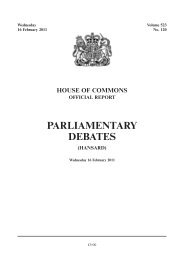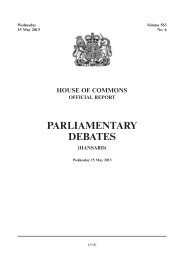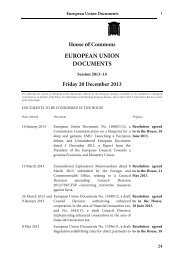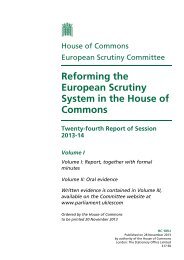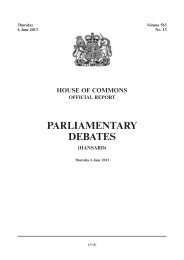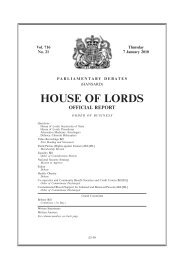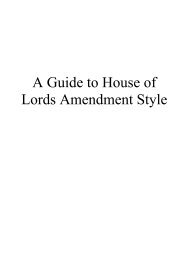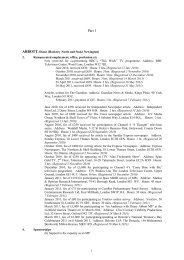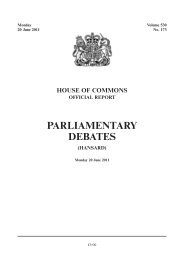Ticketing and Concessionary Travel on Public Transport - United ...
Ticketing and Concessionary Travel on Public Transport - United ...
Ticketing and Concessionary Travel on Public Transport - United ...
You also want an ePaper? Increase the reach of your titles
YUMPU automatically turns print PDFs into web optimized ePapers that Google loves.
<strong>Transport</strong> Committee: Evidence Ev 111<br />
For the Tamar Valley Line the last year of the Wessex franchise produced 111k passengers (single<br />
passenger trips), of whom 15.8% were over 60 <str<strong>on</strong>g>and</str<strong>on</strong>g> yielded £213k in fares revenue. C<strong>on</strong>cessi<strong>on</strong> eligible<br />
passengers would include some groups other than pensi<strong>on</strong>ers <str<strong>on</strong>g>and</str<strong>on</strong>g> using 16% would yield 17,760 journeys,<br />
rounding up to 18K should produce a c<strong>on</strong>servative estimate. The average fare is £1.92, so reimbursement to<br />
the TOC if those journeys were free would be £34.6k pa. (£14.4k of which falls <strong>on</strong> WDBC—see Appendix 7)<br />
Grossing this to the 50 CRs should obviously not be d<strong>on</strong>e by multiplying the TVL cost by 50 as the CRs<br />
vary in length (<str<strong>on</strong>g>and</str<strong>on</strong>g> therefore average fare) <str<strong>on</strong>g>and</str<strong>on</strong>g> use level. The train-miles operated <strong>on</strong> a CR will reflect<br />
frequency of the trains, which should crudely reflect use level <str<strong>on</strong>g>and</str<strong>on</strong>g> the mileage element should reflect journey<br />
length/average fare. It is assumed that the % of pensi<strong>on</strong>ers in the populati<strong>on</strong> across the 50 CRs is not too<br />
dissimilar to that of TVL. The <strong>on</strong>ly other estimate of the cost of c<strong>on</strong>cessi<strong>on</strong> fares <strong>on</strong> CRs known to the<br />
author is from TAITH for the C<strong>on</strong>wy Valley Line <str<strong>on</strong>g>and</str<strong>on</strong>g> the Welsh secti<strong>on</strong> of the Borderline. The CVL figure<br />
was £57k.<br />
The author deduced the train-miles for each CR at the time of publicati<strong>on</strong> of CRDS. To test the idea that<br />
the cost of c<strong>on</strong>cessi<strong>on</strong> fares could be proporti<strong>on</strong>al to train-miles the value of CVL/TVL is 2.29 for trainmiles<br />
<str<strong>on</strong>g>and</str<strong>on</strong>g> 1.65 for the cost of c<strong>on</strong>cessi<strong>on</strong> reimbursement. The figures will never be exactly equal as any two<br />
CRs will have slightly diVerent % pensi<strong>on</strong>ers, diVerent alternative bus services, access to stati<strong>on</strong>s etc. but<br />
both values being within 0.35 around a value of two lends some support to the hypothesis. Without better<br />
data an alternative estimate is not possible but a range can be put <strong>on</strong> the estimate by using CVL <str<strong>on</strong>g>and</str<strong>on</strong>g> TVL<br />
separately as well as combined. The 50,420 train-miles used are for <strong>on</strong>e day from the M<strong>on</strong>/Fri timetable at<br />
the time of CRDS publicati<strong>on</strong>.<br />
TVL Estimate £34.6k x (50420/240) % £7.2 milli<strong>on</strong>.<br />
CVL Estimate £57.0k x (50420/550) % £5.2 milli<strong>on</strong>.<br />
Combined Estimate £91.6k x (50420/790) % £5.9m<br />
Hence, the central estimate would be taken as £5.9 milli<strong>on</strong> but the range should be borne in mind.<br />
However, this central estimate is likely to be an over estimate of the total “new public m<strong>on</strong>ey” needed, for<br />
two reas<strong>on</strong>s.<br />
1. If c<strong>on</strong>cessi<strong>on</strong> fares are oVered <strong>on</strong> CRs there will be some transfer of c<strong>on</strong>cessi<strong>on</strong> use from bus to CR.<br />
Appendix 5 shows that local rail fares are cheaper than bus in most cases. Thus the total reimbursement to<br />
bus <str<strong>on</strong>g>and</str<strong>on</strong>g> CR operators should show a net reducti<strong>on</strong><br />
2. About 20% of CRs are located in areas identified in Appendix 4 <str<strong>on</strong>g>and</str<strong>on</strong>g> already enjoy c<strong>on</strong>cessi<strong>on</strong> fares.<br />
Expenditure here would not be “new public m<strong>on</strong>ey”.<br />
Quantifying the eVect of these two factors is not easy <str<strong>on</strong>g>and</str<strong>on</strong>g> the result should be viewed with cauti<strong>on</strong>. If the<br />
use level of the 20% of CRs already having c<strong>on</strong>cessi<strong>on</strong> fares were that of the average CR, the “new m<strong>on</strong>ey”<br />
central estimate would be closer to £4.8 milli<strong>on</strong>. Appendix 5 shows that for Dev<strong>on</strong> & Cornwall CRs the<br />
average saving to the c<strong>on</strong>cessi<strong>on</strong> budgets for each pass holder switching from bus to CR is £1.75. Lack of<br />
data makes an estimate of the likely level of bus to CR switching diYcult but a switch of <strong>on</strong>e milli<strong>on</strong> journeys<br />
pa from bus to the 50 CRs would reduce the “new m<strong>on</strong>ey” bill to <strong>on</strong>ly just over £3 milli<strong>on</strong>. Paragraph 35<br />
shows that transfer levels can be high (46%) when measured in the other directi<strong>on</strong>.<br />
Share of Costs<br />
APPENDIX 7<br />
SHARE OF TVL CONCESSION COST BETWEEN CARADON AND WDBC AND<br />
GENERATION OF PASSENGERS<br />
The total estimate (Appendix 6) of the cost of free c<strong>on</strong>cessi<strong>on</strong> fares <strong>on</strong> TVL of £34.6k pa is based <strong>on</strong> all<br />
18k c<strong>on</strong>cessi<strong>on</strong> passengers. If all CRs are included in an UK wide local bus <str<strong>on</strong>g>and</str<strong>on</strong>g> local tracked mode scheme,<br />
all 18k (plus uncompensated generated use) passengers would be eligible for c<strong>on</strong>cessi<strong>on</strong> travel. If this doesn’t<br />
occur quickly <str<strong>on</strong>g>and</str<strong>on</strong>g> Carad<strong>on</strong> <str<strong>on</strong>g>and</str<strong>on</strong>g> WDBC can be persuaded to make a local ’add <strong>on</strong>’ of TVL, the share of the<br />
cost between the two would be of interest.<br />
Some of the 18k c<strong>on</strong>cessi<strong>on</strong> passengers are leisure travellers from Plymouth <str<strong>on</strong>g>and</str<strong>on</strong>g> bey<strong>on</strong>d but the majority<br />
are residents al<strong>on</strong>g TVL. A c<strong>on</strong>servative estimate is made by assuming that all 18k c<strong>on</strong>cessi<strong>on</strong> passengers<br />
are from the two council’s areas. The passenger split overall Carad<strong>on</strong>:WDBC is 55:45 <str<strong>on</strong>g>and</str<strong>on</strong>g> is assumed the<br />
same for c<strong>on</strong>cessi<strong>on</strong> use. The oV-peak day return fare from Gunnislake <str<strong>on</strong>g>and</str<strong>on</strong>g> Calstock (in Carad<strong>on</strong>) are the<br />
same at £4.00. Bere Alst<strong>on</strong> <str<strong>on</strong>g>and</str<strong>on</strong>g> Bere Ferres (in WDBC) have the same oV-peak return at £3.50.<br />
Carad<strong>on</strong> costs should exceed WDBC costs by a factor of (55/45)x(400/350)%1.4<br />
Carad<strong>on</strong> cost £34.6k x (1.4/2.4)%£20.2k<br />
WDBC cost £34.6k x (1.0/2.4)%£14.4k



